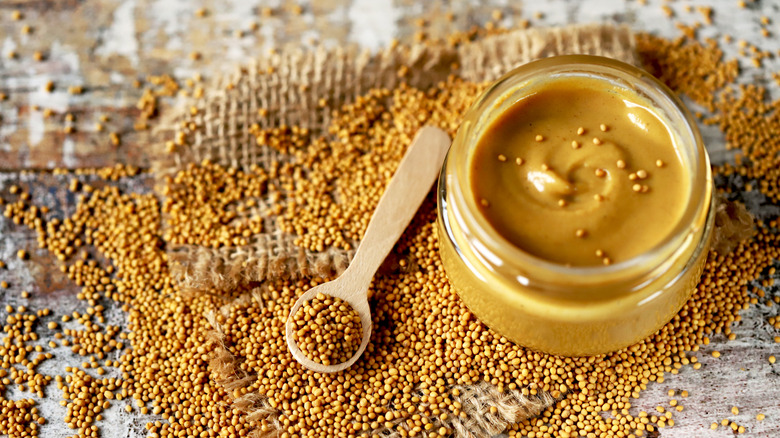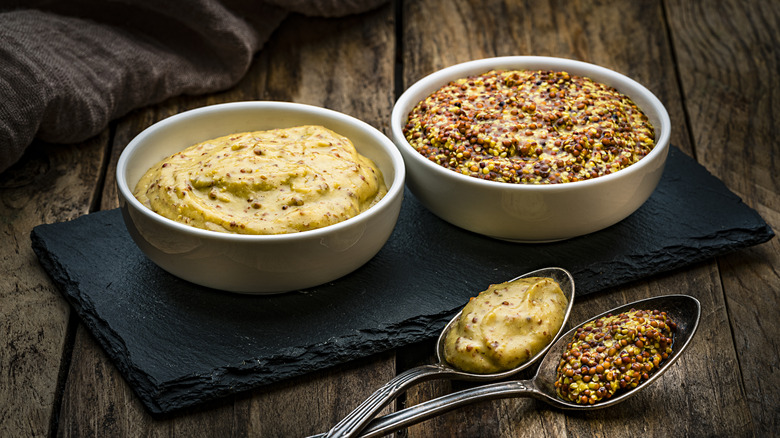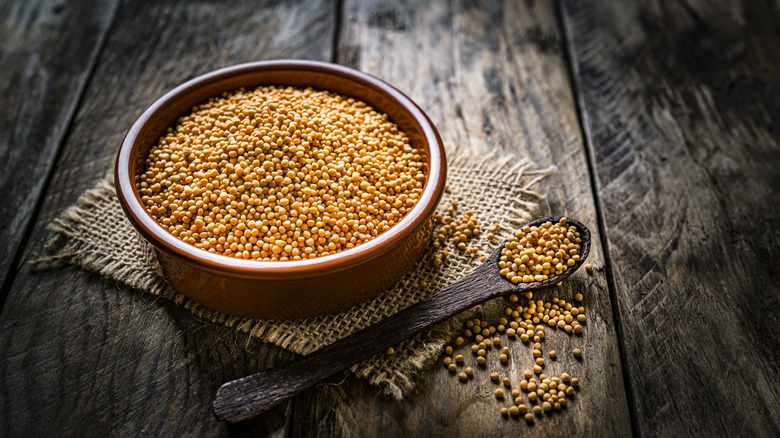Why Is It Called Dijon Mustard?
It's creamy, delicious, and distinctly French. Dijon mustard is the topping of choice for a truly delicious ham sandwich and even fits well in a charcuterie board, playing well with sweet and savory pairings. But have you ever wondered why Dijon mustard is called — well, Dijon mustard? It's probably no surprise to any Francophile that the name derives from the French city of Dijon, which is located in Burgundy and known for its wine.
And that Burgundy-produced wine is also key to the origin of Dijon mustard. The special, creamy type of mustard was invented in 1856 by Dijon resident Jean Naigeon, who added unripe grape juice to mustard — rather than the usual vinegar — giving it a creamy texture and lower acidity. The unripe grape juice used to produce Dijon mustard is a sour and tangy ingredient called verjuice.
The city of Dijon has been a hub for mustard making since the Middle Ages, primarily using brown mustard seeds. And of course, Dijon mustard takes its name from the city, paying homage to its rich history with the condiment. However, many French mustards use whole mustard seed and have a coarse texture and more pungent flavor, making Dijon a true standout.
A French way of mustard
But don't assume that all mustards labeled Dijon are created equal. Don't mistake the Dijon label for an indication of the mustard's origin. Unlike other French food items named after their place of origin — such as Champagne — products labeled Dijon mustard are not restricted by their geographic origin. This is because Dijon mustard is not an appellation-controlled product. The AOC, or appellation d'origine contrôlée, is a French certification that indicates the specific region of origin for many agricultural products. This program ensures that certain goods are grown properly — in the correct soil and climate — to produce an ideal item.
However, just because Dijon mustard isn't restricted by this program, it doesn't mean that there aren't steps you can take to acquire an honest and truly delicious Dijon mustard. To make sure you are getting a true Dijon mustard, simply look for the letters "IGP" on your mustard container. IGP stands for Indication Géographique Protégée, and it indicates that the mustard seeds contained in your Dijon are from both local mustard seeds and local wine. The wine usually used for Dijon is Aligoté, though Chardonnay and Chablis are also used in Dijon mustard.
Variations on a classic seed
Of course, Dijon mustard is not a ubiquitous product, and it can be made in a variety of ways with varying ingredients. Some Dijon mustards use coarse ground seeds, while others are smooth. And some Dijon mustards still use verjuice rather than wine, while others use a combination of both. One particular standout among Dijon mustards is the Edmond Fallot black currant Dijon mustard, which combines the flavor of black currant with mustard to create a pink color and distinct flavor. Edmond Fallot also makes a Dijon mustard that uses Pinot Noir, a type of red wine as opposed to white, which is typically used in Dijon mustards.
Getting to know the almost infinite variations of mustard — a condiment that ranges from the classic American yellow mustard to honey mustard, and spicy brown mustard to the beloved Dijon — can help you fully unleash that little seed's big potential. Dijon in particular, in all of its different forms, makes a delicious addition to many recipes, such as easy deviled eggs and grilled salmon. And you might want to play around with your Dijon types while experimenting in the kitchen. You might just open up a whole new world, or French region, of flavor.


